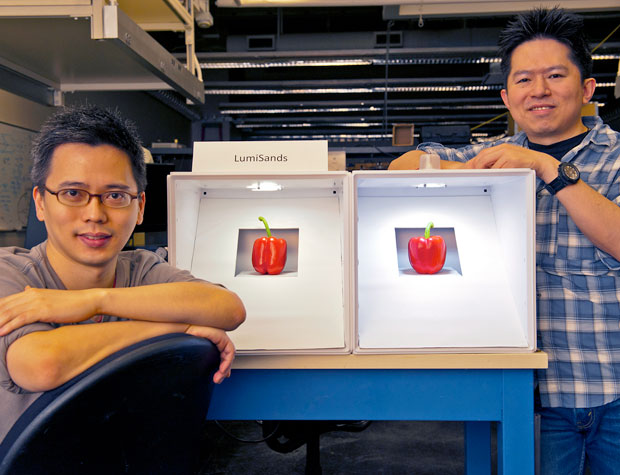
Light-emitting diodes, or LEDs, are the most efficient and environmentally friendly light bulbs on the market. But they come at a higher up-front price than other bulbs, especially the ones with warmer and more appealing hues.
Researchers at the University of Washington have created a material they say would make LED bulbs cheaper and greener to manufacture, driving down the price. Their silicon-based nanoparticles soften the blue light emitted by LEDs, creating white light that more closely resembles sunlight.
The company, LumiSands, started as a graduate student project for CEO Chang-Ching Tu, who received his doctorate in electrical engineering at the UW and just completed a stint as a postdoctoral researcher in materials science and engineering. This spring, the start-up company spun out from the UW Center for Commercialization, a process that its two founders hope will lead to signing a commercialization license for the technology.
LEDs give off light when electrons move through a semiconductor material. They are more efficient than standard incandescent or fluorescent bulbs, but they're also pricier. That's partly because within each LED lamp, expensive substances known as rare-earth-element phosphors help to soften the harsh blue light that LEDs naturally emit.
But these rare-earth elements are hazardous to extract and process. China controls nearly all of the market for these materials, which has quadrupled the average price for the past several years.
That's where LumiSands comes in. The company uses silicon, derived from sand, instead of rare-earth elements to convert part of the blue light emitted by LEDs into greens, yellows and reds. The resulting light looks more like sunlight.
The crew of two plans to sell directly to LED-bulb manufacturers that are looking to transition away from increasingly more expensive materials to make the lights.
"Hopefully, manufacturers could substitute traditional rare-earth elements with our material with minimal additional steps," said Ji Hoo, a UW doctoral student in electrical engineering and co-founder of LumiSands. "It will be cheaper, better-quality lighting for users."
Incandescent bulbs give off light that's most similar to sunlight – and easiest on our eyes – but the bulbs are inefficient and produce a lot of heat. Fluorescent bulbs, seen most commonly as long tubes in overhead office light fixtures, are more efficient than incandescent lights, but they contain mercury, posing health and environmental concerns.
LumiSands etches off nano-sized particles from wafers of silicon. The element, which usually doesn't emit light, can start to glow when its crystalline particle size is smaller than 5 nanometers. The surface is reinforced through a wet-chemistry process. When the red-emitting silicon nanoparticles are added to LED bulbs, the light becomes softer and warmer in hue.
"The beauty of our technology is to create a highly efficient fluorescent material by using silicon rather than rare-earth elements or other types of heavy-metal compound semiconductors," Tu said. "The manufacturing process can be performed in a basic laboratory setting and is easy to scale up."
LumiSands plans to tweak the red technology before moving on to other colors such as yellow and green, which will enable LEDs to cast a white light with no rare-earth elements.












